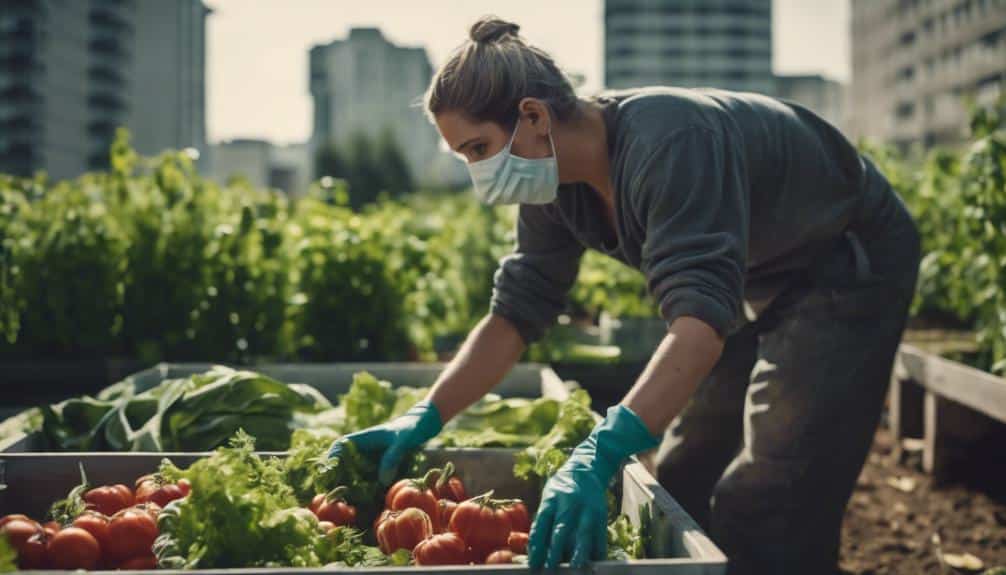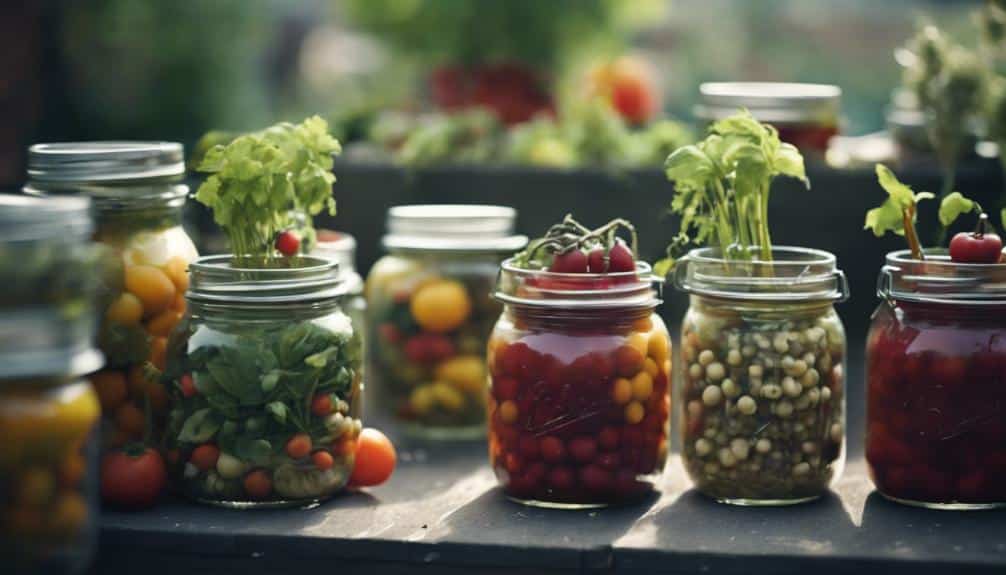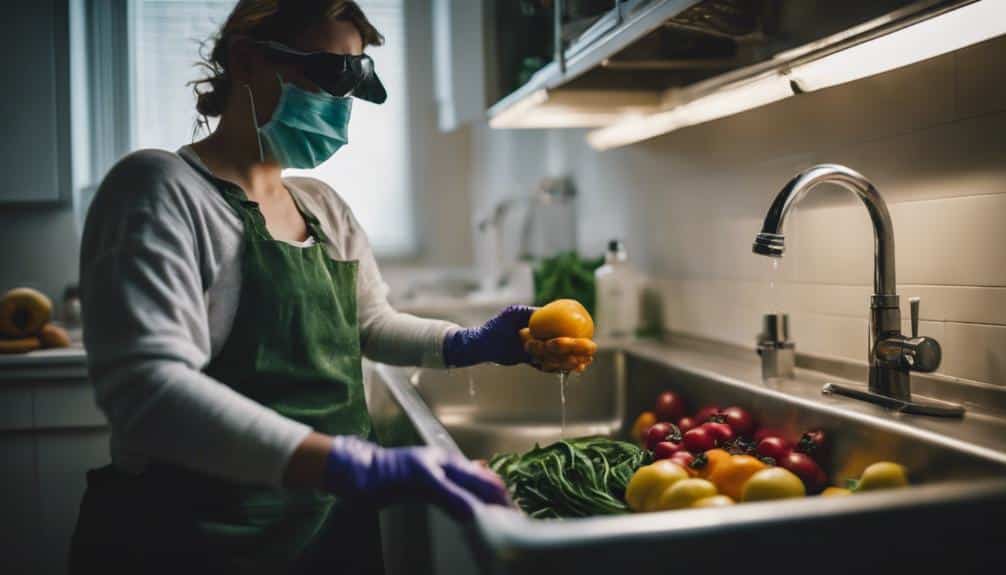When canning and preserving urban-grown produce, first test the soil for pollutants. Store your items in cool, dark places to keep them fresh.
Ensure food safety by choosing clean harvesting spots and managing pests effectively. Save energy by processing in small batches with energy-efficient equipment.
We thought it's essential to know how you can build a compost bin even if you have a small urban garden. In this guide we've explored how to use vertical gardening techniques for small spaces.
Potential Contamination from Urban Pollutants

To address potential contamination from urban pollutants when preserving urban-grown produce, conduct thorough soil and plant testing for harmful substances.
Start by reaching out to local agricultural extension services or labs that specialize in testing for contaminants like heavy metals, pesticides, and other harmful chemicals. They can provide guidance on how to collect samples properly and interpret the results.
Once you have the test results, follow any recommendations for remediation or mitigation provided. This could involve strategies like using raised beds with new soil, incorporating soil amendments to bind contaminants, or selecting plants known for their ability to uptake fewer toxins.
Unique Storage Considerations for Urban-preserved Foods
Urban-preserved foods demand careful attention to storage conditions due to the unique environmental factors present in urban settings. In urban areas, temperature and humidity levels can fluctuate more rapidly than in rural settings, affecting the shelf life of preserved foods.
It’s better to store canned or preserved items in a cool, dark place to maintain their quality. Consider using a pantry or cellar with consistent temperatures to guarantee ideal storage conditions.
Urban environments may be more prone to pest infestations, such as rodents or insects, which can compromise the safety of preserved foods.
To prevent this, make sure your storage area is well-sealed and free of any entry points for pests. Using airtight containers or vacuum-sealing can help safeguard your preserved goods from contamination.
Canning and Preserving Techniques for Small-scale Urban Gardens?

Adapting canning and preserving techniques for small-scale urban gardens requires innovative approaches to maximize limited space and diverse produce yields.
In your compact urban garden, where space is precious, consider using smaller-sized canning equipment such as mini jars or half-pint containers. These are ideal for preserving small batches of herbs, cherry tomatoes, or peppers that you harvest from your urban oasis.
You can follow techniques like refrigerator pickling for quick preservation of cucumbers or radishes. This method eliminates the need for traditional canning equipment and can be easily done in your urban kitchen. For herbs like basil or parsley, drying them in small batches is a space-efficient way to preserve their flavors.
Urban community Collaborations
Pooling resources and collaborating within urban communities can greatly enhance the efficiency and success of canning and preserving efforts. Here are some effective strategies for building community networks and sharing best practices among urban food growers and preservers:
- Community Workshops: Organize workshops where experienced canners can share their knowledge with beginners. This allows for skill-sharing and fosters a sense of community among urban growers.
- Tool Sharing: Create a tool-sharing program where community members can borrow canning equipment they may not have access to. This reduces individual costs and promotes sustainability.
- Seed Swaps: Host seed swap events where gardeners can exchange seeds and seedlings. This promotes diversity in urban gardens and encourages collaboration among growers.
- Preservation Parties: Arrange preservation parties where neighbors can come together to can and preserve produce in a fun and social setting. This not only increases efficiency but also strengthens community bonds.
Potential Food Safety Concerns Specific to Urban Environments

Addressing potential food safety concerns specific to urban environments requires careful consideration of the unique challenges posed by factors such as exposure to pests, contaminated water sources, and improper waste disposal.
To combat these issues, start by making sure that the urban-grown produce is harvested from clean and well-maintained areas. Implement pest control measures like using screens on windows, sealing cracks, and storing food in airtight containers to prevent contamination.
Only use safe and clean water sources for irrigation and washing produce to avoid microbial contamination.
Proper waste management is vital to prevent the spread of pathogens. Encourage composting organic waste properly and disposing of non-compostable waste in designated areas to maintain a hygienic environment.
Energy and resource considerations for urban canning and preserving
Considering the limited space and resources characteristic of urban living, urban gardeners can effectively minimize the energy and resource demands of canning and preserving activities while ensuring safety and quality.
Here are some tips to help you navigate the energy and resource considerations for urban canning and preserving:
- Opt for Small Batches: Canning small quantities at a time reduces energy consumption and allows you to make the most of limited space.
- Use Energy-Efficient Appliances: When possible, choose energy-efficient canning equipment to lower electricity usage.
- Plan Ahead: Coordinate your canning schedule with local harvest seasons to capitalize on fresh produce and reduce transportation energy.
- Consider Alternative Preservation Methods: Explore drying, fermenting, or pickling as energy-saving alternatives to traditional canning techniques.
Frequently Asked Questions
How Can You Test for Urban Pollutants in Produce for Canning?
To test for urban pollutants in produce for canning, you can send samples to a lab for analysis. They’ll check for contaminants like heavy metals and pesticides. Make sure to follow safety guidelines for handling and packaging.
Are There Special Containers for Storing Urban-Preserved Foods?
When storing urban-preserved foods, opt for airtight containers like mason jars or vacuum-sealed bags. These special containers maintain freshness and prevent spoilage. Proper storage guarantees your preserved goodies stay safe, delicious, and ready to enjoy.
What Are the Best Methods for Canning in Limited Urban Spaces?
When canning in limited urban spaces, prioritize efficiency. Opt for compact tools like small canning kits and stackable jars. Consider vertical storage to maximize space. Utilize multi-functional kitchen gadgets for easy preservation.
How Can Urban Neighborhoods Organize Canning Workshops?
To organize canning workshops in urban neighborhoods, start by reaching out to local community centers or organizations. Create a schedule, gather supplies, and promote the event through social media and flyers. Encourage neighbors to join and learn together.
What Are the Environmental Impacts of Urban Canning Processes?
Consider the environmental impacts of urban canning processes. Reduce food waste, decrease transportation emissions, and promote local food systems. By participating in canning, you actively contribute to sustainability efforts in your community.
